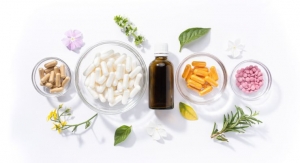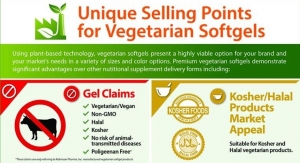Rebecca Wright01.01.07
Nutrition Business Journal (NBJ) reports the supplement market in the U.S., which is currently worth over $21 billion, will grow 4-5% between now and 2012. This growth, some experts say, is dependent on how effective supplements are, and that has everything to do with how they are delivered.
There has been much activity on the delivery front over the last several years, a lot of companies working toward condensing dosages to make pills smaller and more potent, while others continue to experiment with more cutting-edge technologies such as edible films. On the food and beverage front, companies are working hard on solubility and microencapsulation to make the presence of nutraceuticals in various systems more subtle, or better yet, invisible. And don't forget about nanotechnology, the littlest technology likely to make the biggest impact on the nutraceuticals industry of the future.
One of the most important issues in formulation is matching the right delivery system to a particular ingredient, or combination of ingredients. Kenn Israel, vice president of marketing, Robinson Pharma, Inc., Santa Ana, CA, explained. "It is really important to apply the right delivery system to a nutrient. For example, soft gels may work well for some lipid soluble ingredients but may not work well for certain water soluble ingredients," he said. "Going forward companies must move away from sweeping judgments pertaining to the blanket application of one delivery system to a variety of nutrients and embrace matching the delivery technology to the ingredient."
The function of any delivery system can be described on many levels, according to Winston Samuels, president and CEO, Maxx Performance, Chester, NY, who said they can enhance solubility, facilitate controlled release, improve bioavailability, and protect the stability of micronutrients and bioactive compounds during processing, storage, and distribution. But ultimately, he pointed out, understanding the mechanism of targeted delivery will provide a foundation that will enable food and supplement manufacturers to design "smart" systems capable of ensuring optimal health.
"Certain drugs, for example, have to be used at higher dosages in order to achieve optimum response. This is because some of the contents are broken down before reaching the site where it's needed," Mr. Samuels said. "Typically, in this case, manufacturers compensate for this loss by increasing the dosage. Using 'smart' delivery systems, the amount of drugs or nutraceutical ingredients needed to illicit response could be dramatically reduced in the formulation stage."
Mr. Samuels said companies are also coupling nutrients that have synergistic activity. For example, product developers are working on delivering antioxidant vitamins like C and E in a single microencapsulated particle to reduce stress. Similarly, Mr. Samuels said, the delivery of iron and vitamin C together could aid iron absorption.
Some of the other ingredients driving advances in delivery today include CoQ10. "This ingredient really initiated the 'delivery war' because it is expensive and typically has poor bioavailability. Tremendous effort was put into enhancing the bioavailability of CoQ10, the first successful efforts of which included soft gel formulations," Mr. Israel explained, adding, "Now the industry has come full circle, offering improved bioavailability dried powders utilizing different delivery technologies, such as liposomes and nanoparticles that lend themselves well toward tableting, encapsulation and beverage application."
Another ingredient class that has heightened the importance of bioavailability and protection is probiotics. "I think we are finally at a point where issues surrounding tableting and encapsulating probiotics effectively have been solved," Mr. Israel said. "We are now at the threshold of some interesting developments in soft gels effectively delivering 'active' payloads of probiotics."
Companies such as Lycored, Beer-Sheva, Israel, and DSM Nutritional Products, Inc., Parsippany, NJ, are utilizing beadlet technology to increase potency and protect nutrients, therefore making them more cost effective because they reduce some of the overage issues that go hand in hand with formulation. "Beadlets provide an advantage when you are handling an ingredient class like carotenoids because they are very sensitive to light and heat, so the more you can protect them the better off the formulation is as far as bioavailability, potency and absorption," said Lycored's vice president of marketing and business development, Scott Larkin. In April last year Lycored launched co-beadlet technology to simplify the manufacturing process, reduce production and inventory costs, and decrease overages in tablets and capsules.
New from DSM on the beadlet front is Actilease, a technology that consists of tiny droplets of micronutrients packaged inside a protective food starch or gelatin matrix. This matrix protects the nutrients during manufacturing and storage and then releases them in the stomach so they can be absorbed by the body.
In addition to maximizing nutrient absorption, DSM also claims the technology prevents tableting losses and interactions with other compounds. Actilease beadlets also provide superior stability and very low extrusion loss, which translate to lower overages and smaller tablets. Lastly, convenient handling characteristics are provided by the low hygroscopicity, excellent flowability and uniform particle size.
Film technology seems to be taking a firm hold of the nutraceuticals industry. Given the technology's recent success, which the United States Department of Agriculture (USDA) claims brought in more than $100 million last year, many companies continue to experiment with this delivery system. One such company is Watson Foods, West Haven, CT, which has expertise in soluble film technology. "What people usually think of when discussing film technology is the Listerine PocketPacks strips, which utilize 'quick dissolve' technology," said Marie Garnich, vice president of global business development and sales, Watson Foods-Film Technology Division. "Our company is able to offer a wide range of film technologies, from quick dissolve strips to slower dissolving strips. We also offer films that adhere to the buccal cavity (oral cavity) or gums, and last up to three hours. Film technology really continues to evolve into some exciting areas."
According to Watson's' Film Technology Division, the largest market for films strips is represented by teens and adults from 18 to 25 years of age. An untapped market opportunity, the company suggests, is children under 13 years of age, which could be targeted with candy flavored, sweetened or sour flavored films.
There are plenty of nutraceuticals that would fit well with film technology, according to Ms. Garnich. "The quick dissolve strip, for example, would be particularly suited for vitamin B12, which could be absorbed right under the tongue and enter the bloodstream faster," she said. "However, companies should know there are some limits as far as the amount of active a film can carry."
A film active is typically 30% of the total weight of the formula. In other words, if you have a 120 mg film strip you can only deliver about 36 mg as the active. So applying edible film technology to an ingredient like calcium probably wouldn't make sense because it is usually delivered in much larger doses. Ingredients such as vitamin C, which could be delivered various times throughout the day at a lower dosage would probably be more suitable.
"Films are good for applications that offer an immediate benefit like pain relief," said Ms. Garnich, adding, "but another great application in the context of the health and wellness market would be a diet product." She explained further, "When you're on a diet it would be beneficial to be reminded several times throughout the day. If you had a film that contained an ingredient providing satiation and also made your mouth feel fresh, I think that would be a great combination."
Maxx Performance's Mr. Samuels explained microencapsulation as a process in which tiny pieces of an ingredient are packaged or encapsulated within another material in order to protect it from the surrounding environment. These ingredients can be released from their shells in various ways: mechanical rupture of the capsule wall, dissolution of the wall, melting of the wall and diffusion through the wall. "There are current methodologies in the manufacturing and processing of drugs, cosmetics and foods, which have presented a myriad of problems that microencapsulation can solve," he said. "These include taste and odor masking, preventing ingredient interactions and improving hygroscopicity."
Mr. Samuels continued, "Even though particle size may be different, advances in microencapsulation technology now permit the coating of multiple ingredients that may not have the same morphology. Manufacturers are keen to take advantage of this breakthrough because it opens up new opportunities that were not previously available."
A nanometer is one billionth of a meter. To put that in perspective, a human hair is 80,000 nanometers wide. But experts predict this small technology, the smallest to be exact, is going to be one of the biggest things to hit the dietary supplement and functional food markets in years to come.
"Nanotechnology has been around for two decades, but the first wave of applications is only now beginning to break. As it does, it will make the computer revolution look like small change. It will affect everything from the batteries we use to the pants we wear to the way we treat cancer�" This is how National Geographicrecently described the impact of nanotechnology, not as a new wave, but one that has been slowly growing over the last two decades, similar to a tsunami.
Robinson Pharma's Mr. Israel has also noticed the gradual development of this technology in various corners of the supplement industry. Now, he says, the buzz of nanotechnology is starting to catch up and he believes companies should approach it with caution. "Small particle sizes have been around for a long time, so the reality of nano is not entirely new, however recently scientific interest has dramatically increased," he said. "But making everything smaller may not necessarily make everything better. There may be some unforeseen consequences to reducing particle sizes of all ingredients; it is a technology that must be applied intelligently."
For example, Mr. Israel continued, "There has been some evidence showing that some nano particles in synthetic coatings have the ability to cross the skin barrier and enter circulation-and these are compounds we really don't want in our bodies. I think nanotechnology needs to be approached with care and thoughtful consideration because we really don't know what the effects of a lot of our ingredients are on a nano or sub-nano level."
Mr. Israel isn't the only one concerned. FDA set up a "task force" in August last year to figure out how to regulate the hundreds of consumer products that incorporate some aspect of nanotechnology in their development. According to FDA, this task force will identify and recommend ways to address any knowledge or policy gaps that exist so as to better enable the agency to evaluate possible adverse health effects from FDA-regulated products that use nanotechnology materials.
What has FDA so worried is the fact that materials made in the nanoscale size range can often have chemical or physical properties that are different from those of their larger counterparts. Such differences include altered magnetic properties, altered electrical or optical activity, increased structural integrity, and increased chemical and biological activity. Because of these properties, the agency said, nanotechnology materials have great potential for use in a vast array of products. Also because of some of their special properties, they may pose different safety issues than their larger counterparts.
The National Science Foundation, an independent federal agency based in Arlington, VA, claims that by 2010 half of all drugs will be made using nanotechnology. The Tan Sheet (11/27/2006) indicates the nano-engineered food market is expected to surge from $2.6 billion currently to over $20 billion by 2010-that's a lot of growth in just three years. Further, it says nanotech is already used in over 300 consumer products in 17 countries and there are presently more than 200 companies pursuing research in the area of food nanotech, examining more than 180 applications.
But perhaps nanotechnology, at least in the minds of consumers, is something considered out of sight, out of mind. According to a recent study on public perceptions of nanotechnology, U.S. consumers said they are willing to use specific nano-containing products-even if there are health and safety risks-when the potential benefits are high. It also found that U.S. consumers rate nanotechnology as less risky compared to everyday technologies like herbicides, chemical disinfectants, handguns and food preservatives.
The study, which was conducted by researchers at Rice University's Center for Biological and Environmental Nanotechnology (CBEN), University College London (UCL) and the London Business School, is the largest survey yet conducted on public willingness to use commercial nanotechnology products. It was funded by the National Science Foundation through CBEN.
"By some estimates, products containing nanotechnology already account for more than $30 billion in annual global sales, but there is concern that the public's fixation with nanotechnology's risks-either real or imaged-will diminish consumers' appetite for products," said lead researcher Steven Currall, a management and entrepreneurship expert who conducted the research. "Measuring public sentiment toward nanotechnology lets us both check the pulse of the industry right now, and chart the growth or erosion of public acceptance in the future."
The research was based on more than 5,500 survey responses. The surveys defined nanotechnology as involving "human-designed materials or machines at extremely small sizes that have unique chemical, physical, electrical or other properties."
One survey polled consumers about how likely they would be to use four specific nano-containing products: a drug, skin lotion, automobile tires and refrigerator gas coolant. This is the first large-scale study to experimentally gauge the public's reaction to specific, nano-containing products, and Currall said the use of scenarios about plausible, specific products yielded results that challenge the assumption that the public focuses narrowly on risk.
"It was clear that people were thinking about more than risk," he said. "The average consumer is pretty shrewd when it comes to balancing risks against benefits, and we found that the greater the potential benefits, the more risks people are willing to tolerate."
Study co-author Neal Lane, who helped craft the U.S.'s National Nanotechnology Initiative during his tenure as director of the White House's Office of Science and Technology Policy, said the public is likely to become more aware of nanotechnology's risks as environmental health and safety research is completed and as nanomaterials find their way into more products. What remains to be seen is whether the public's budding perceptions of the benefits of nanotechnology will also grow, he said.
There has been much activity on the delivery front over the last several years, a lot of companies working toward condensing dosages to make pills smaller and more potent, while others continue to experiment with more cutting-edge technologies such as edible films. On the food and beverage front, companies are working hard on solubility and microencapsulation to make the presence of nutraceuticals in various systems more subtle, or better yet, invisible. And don't forget about nanotechnology, the littlest technology likely to make the biggest impact on the nutraceuticals industry of the future.
Delivering the Details
One of the most important issues in formulation is matching the right delivery system to a particular ingredient, or combination of ingredients. Kenn Israel, vice president of marketing, Robinson Pharma, Inc., Santa Ana, CA, explained. "It is really important to apply the right delivery system to a nutrient. For example, soft gels may work well for some lipid soluble ingredients but may not work well for certain water soluble ingredients," he said. "Going forward companies must move away from sweeping judgments pertaining to the blanket application of one delivery system to a variety of nutrients and embrace matching the delivery technology to the ingredient."
The function of any delivery system can be described on many levels, according to Winston Samuels, president and CEO, Maxx Performance, Chester, NY, who said they can enhance solubility, facilitate controlled release, improve bioavailability, and protect the stability of micronutrients and bioactive compounds during processing, storage, and distribution. But ultimately, he pointed out, understanding the mechanism of targeted delivery will provide a foundation that will enable food and supplement manufacturers to design "smart" systems capable of ensuring optimal health.
"Certain drugs, for example, have to be used at higher dosages in order to achieve optimum response. This is because some of the contents are broken down before reaching the site where it's needed," Mr. Samuels said. "Typically, in this case, manufacturers compensate for this loss by increasing the dosage. Using 'smart' delivery systems, the amount of drugs or nutraceutical ingredients needed to illicit response could be dramatically reduced in the formulation stage."
Mr. Samuels said companies are also coupling nutrients that have synergistic activity. For example, product developers are working on delivering antioxidant vitamins like C and E in a single microencapsulated particle to reduce stress. Similarly, Mr. Samuels said, the delivery of iron and vitamin C together could aid iron absorption.
Some of the other ingredients driving advances in delivery today include CoQ10. "This ingredient really initiated the 'delivery war' because it is expensive and typically has poor bioavailability. Tremendous effort was put into enhancing the bioavailability of CoQ10, the first successful efforts of which included soft gel formulations," Mr. Israel explained, adding, "Now the industry has come full circle, offering improved bioavailability dried powders utilizing different delivery technologies, such as liposomes and nanoparticles that lend themselves well toward tableting, encapsulation and beverage application."
Another ingredient class that has heightened the importance of bioavailability and protection is probiotics. "I think we are finally at a point where issues surrounding tableting and encapsulating probiotics effectively have been solved," Mr. Israel said. "We are now at the threshold of some interesting developments in soft gels effectively delivering 'active' payloads of probiotics."
Busy Beadlets
Companies such as Lycored, Beer-Sheva, Israel, and DSM Nutritional Products, Inc., Parsippany, NJ, are utilizing beadlet technology to increase potency and protect nutrients, therefore making them more cost effective because they reduce some of the overage issues that go hand in hand with formulation. "Beadlets provide an advantage when you are handling an ingredient class like carotenoids because they are very sensitive to light and heat, so the more you can protect them the better off the formulation is as far as bioavailability, potency and absorption," said Lycored's vice president of marketing and business development, Scott Larkin. In April last year Lycored launched co-beadlet technology to simplify the manufacturing process, reduce production and inventory costs, and decrease overages in tablets and capsules.
New from DSM on the beadlet front is Actilease, a technology that consists of tiny droplets of micronutrients packaged inside a protective food starch or gelatin matrix. This matrix protects the nutrients during manufacturing and storage and then releases them in the stomach so they can be absorbed by the body.
In addition to maximizing nutrient absorption, DSM also claims the technology prevents tableting losses and interactions with other compounds. Actilease beadlets also provide superior stability and very low extrusion loss, which translate to lower overages and smaller tablets. Lastly, convenient handling characteristics are provided by the low hygroscopicity, excellent flowability and uniform particle size.
Nutraceuticals on Film
Film technology seems to be taking a firm hold of the nutraceuticals industry. Given the technology's recent success, which the United States Department of Agriculture (USDA) claims brought in more than $100 million last year, many companies continue to experiment with this delivery system. One such company is Watson Foods, West Haven, CT, which has expertise in soluble film technology. "What people usually think of when discussing film technology is the Listerine PocketPacks strips, which utilize 'quick dissolve' technology," said Marie Garnich, vice president of global business development and sales, Watson Foods-Film Technology Division. "Our company is able to offer a wide range of film technologies, from quick dissolve strips to slower dissolving strips. We also offer films that adhere to the buccal cavity (oral cavity) or gums, and last up to three hours. Film technology really continues to evolve into some exciting areas."
According to Watson's' Film Technology Division, the largest market for films strips is represented by teens and adults from 18 to 25 years of age. An untapped market opportunity, the company suggests, is children under 13 years of age, which could be targeted with candy flavored, sweetened or sour flavored films.
There are plenty of nutraceuticals that would fit well with film technology, according to Ms. Garnich. "The quick dissolve strip, for example, would be particularly suited for vitamin B12, which could be absorbed right under the tongue and enter the bloodstream faster," she said. "However, companies should know there are some limits as far as the amount of active a film can carry."
A film active is typically 30% of the total weight of the formula. In other words, if you have a 120 mg film strip you can only deliver about 36 mg as the active. So applying edible film technology to an ingredient like calcium probably wouldn't make sense because it is usually delivered in much larger doses. Ingredients such as vitamin C, which could be delivered various times throughout the day at a lower dosage would probably be more suitable.
"Films are good for applications that offer an immediate benefit like pain relief," said Ms. Garnich, adding, "but another great application in the context of the health and wellness market would be a diet product." She explained further, "When you're on a diet it would be beneficial to be reminded several times throughout the day. If you had a film that contained an ingredient providing satiation and also made your mouth feel fresh, I think that would be a great combination."
The Miracle of Microencapsulation
Maxx Performance's Mr. Samuels explained microencapsulation as a process in which tiny pieces of an ingredient are packaged or encapsulated within another material in order to protect it from the surrounding environment. These ingredients can be released from their shells in various ways: mechanical rupture of the capsule wall, dissolution of the wall, melting of the wall and diffusion through the wall. "There are current methodologies in the manufacturing and processing of drugs, cosmetics and foods, which have presented a myriad of problems that microencapsulation can solve," he said. "These include taste and odor masking, preventing ingredient interactions and improving hygroscopicity."
Mr. Samuels continued, "Even though particle size may be different, advances in microencapsulation technology now permit the coating of multiple ingredients that may not have the same morphology. Manufacturers are keen to take advantage of this breakthrough because it opens up new opportunities that were not previously available."
Nanotechnology: Little Technology, BIG Impact
A nanometer is one billionth of a meter. To put that in perspective, a human hair is 80,000 nanometers wide. But experts predict this small technology, the smallest to be exact, is going to be one of the biggest things to hit the dietary supplement and functional food markets in years to come.
"Nanotechnology has been around for two decades, but the first wave of applications is only now beginning to break. As it does, it will make the computer revolution look like small change. It will affect everything from the batteries we use to the pants we wear to the way we treat cancer�" This is how National Geographicrecently described the impact of nanotechnology, not as a new wave, but one that has been slowly growing over the last two decades, similar to a tsunami.
Robinson Pharma's Mr. Israel has also noticed the gradual development of this technology in various corners of the supplement industry. Now, he says, the buzz of nanotechnology is starting to catch up and he believes companies should approach it with caution. "Small particle sizes have been around for a long time, so the reality of nano is not entirely new, however recently scientific interest has dramatically increased," he said. "But making everything smaller may not necessarily make everything better. There may be some unforeseen consequences to reducing particle sizes of all ingredients; it is a technology that must be applied intelligently."
For example, Mr. Israel continued, "There has been some evidence showing that some nano particles in synthetic coatings have the ability to cross the skin barrier and enter circulation-and these are compounds we really don't want in our bodies. I think nanotechnology needs to be approached with care and thoughtful consideration because we really don't know what the effects of a lot of our ingredients are on a nano or sub-nano level."
Mr. Israel isn't the only one concerned. FDA set up a "task force" in August last year to figure out how to regulate the hundreds of consumer products that incorporate some aspect of nanotechnology in their development. According to FDA, this task force will identify and recommend ways to address any knowledge or policy gaps that exist so as to better enable the agency to evaluate possible adverse health effects from FDA-regulated products that use nanotechnology materials.
What has FDA so worried is the fact that materials made in the nanoscale size range can often have chemical or physical properties that are different from those of their larger counterparts. Such differences include altered magnetic properties, altered electrical or optical activity, increased structural integrity, and increased chemical and biological activity. Because of these properties, the agency said, nanotechnology materials have great potential for use in a vast array of products. Also because of some of their special properties, they may pose different safety issues than their larger counterparts.
The National Science Foundation, an independent federal agency based in Arlington, VA, claims that by 2010 half of all drugs will be made using nanotechnology. The Tan Sheet (11/27/2006) indicates the nano-engineered food market is expected to surge from $2.6 billion currently to over $20 billion by 2010-that's a lot of growth in just three years. Further, it says nanotech is already used in over 300 consumer products in 17 countries and there are presently more than 200 companies pursuing research in the area of food nanotech, examining more than 180 applications.
But perhaps nanotechnology, at least in the minds of consumers, is something considered out of sight, out of mind. According to a recent study on public perceptions of nanotechnology, U.S. consumers said they are willing to use specific nano-containing products-even if there are health and safety risks-when the potential benefits are high. It also found that U.S. consumers rate nanotechnology as less risky compared to everyday technologies like herbicides, chemical disinfectants, handguns and food preservatives.
The study, which was conducted by researchers at Rice University's Center for Biological and Environmental Nanotechnology (CBEN), University College London (UCL) and the London Business School, is the largest survey yet conducted on public willingness to use commercial nanotechnology products. It was funded by the National Science Foundation through CBEN.
"By some estimates, products containing nanotechnology already account for more than $30 billion in annual global sales, but there is concern that the public's fixation with nanotechnology's risks-either real or imaged-will diminish consumers' appetite for products," said lead researcher Steven Currall, a management and entrepreneurship expert who conducted the research. "Measuring public sentiment toward nanotechnology lets us both check the pulse of the industry right now, and chart the growth or erosion of public acceptance in the future."
The research was based on more than 5,500 survey responses. The surveys defined nanotechnology as involving "human-designed materials or machines at extremely small sizes that have unique chemical, physical, electrical or other properties."
One survey polled consumers about how likely they would be to use four specific nano-containing products: a drug, skin lotion, automobile tires and refrigerator gas coolant. This is the first large-scale study to experimentally gauge the public's reaction to specific, nano-containing products, and Currall said the use of scenarios about plausible, specific products yielded results that challenge the assumption that the public focuses narrowly on risk.
"It was clear that people were thinking about more than risk," he said. "The average consumer is pretty shrewd when it comes to balancing risks against benefits, and we found that the greater the potential benefits, the more risks people are willing to tolerate."
Study co-author Neal Lane, who helped craft the U.S.'s National Nanotechnology Initiative during his tenure as director of the White House's Office of Science and Technology Policy, said the public is likely to become more aware of nanotechnology's risks as environmental health and safety research is completed and as nanomaterials find their way into more products. What remains to be seen is whether the public's budding perceptions of the benefits of nanotechnology will also grow, he said.




















